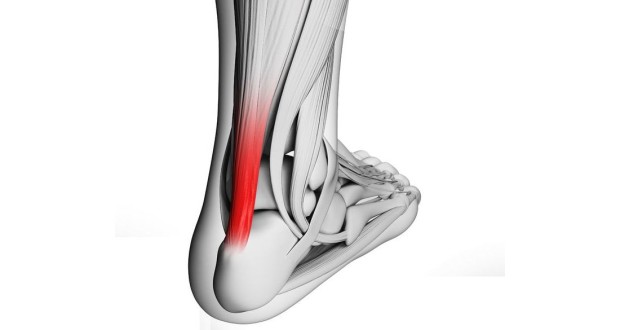Though the only flaw of legendary Greek hero Achilles was his heel, it would be unfair to characterize the Achilles tendon as some sort of brittle piece of tissue. On the contrary, the Achilles tendon is the largest and strongest tendon in the body. Like other tendons, the purpose of the Achilles’ tendon is to serve as a bridge between muscles and bone, connecting and transferring force between these key bodily components. A long band of fibrous and flexible tissue, the Achilles’ tendon is designed to connect the calf muscles to the heel bone.
Daily life would be much different (and much more difficult) without a fully functioning Achilles’ tendon. Your Achilles allows you to perform a plantar flexion movement. In plain English, this means that you are able to bend your foot and toes in a downwards motion. This may not seem that impressive, but this small feat allows the body to jump, sprint and climb walls. Even the simple act of walking utilizes the Achilles tendon.
Injury, Pain and Tendonitis
Tendonitis, an ailment that affects millions of Americans, is an affliction that strikes the body’s tendons, causing them to become swollen and irritated. This inflammation is typically accompanied by a fair amount of pain. Unlike other physical injuries, which occur due to the impact of external forces, tendonitis develops after a certain tendon has been overworked.
There are two specific types of tendonitis that can impact the Achilles tendon. Noninsertional Achilles tendonitis concentrates its attack on the middle section of the tendon, causing tiny tears in the tendon’s fibers. These fibers may also swell and thicken in size. By contrast, insertional Achilles tendonitis affects the lower portion of the Achilles, where the tendon attaches to the heel bone.
Aside from inflammation, both types of Achilles tendonitis can cause tendon fibers to harden, a process known as calcification. This can cause the development of bone spurs, growths that form on bone surfaces, in patients with insertional Achilles tendonitis. Bone spurs can grind against surrounding tissues, leading to pain and discomfort. Regardless of which type of Achilles tendonitis develops, the patient can usually expect to encounter at least some of following symptoms:
- Pain and stiffness in the afflicted tendon during the morning hours.
- Pain in the back of the heel or Achilles tendon. This pain can be further aggravated as the patient walks around.
- Intense pain after an exercise workout.
- A thicker tendon.
- Visible swelling that increases as the tendon is used throughout the day.
- Bone spurs (if the patient has insertional Achilles tendonitis).
Since tendonitis is typically brought about by overworking the body, doctors advise patients to rest inflamed tendons, and will likely encourage them to ice the tendon for up to 20 minute intervals. This tactic can be used several times throughout the day. Non-steroidal anti-inflammatory medications (NSAIDs) are another tool for dulling Achilles pain.
Repairing a Torn Achilles
As with any other tendon in the human body, the Achilles tendon can be stretched to the point of tearing, referred to as Achilles’ tendon ruptures. Because ruptures are caused when significant stress placed is upon the tendon, Achilles tears usually occur while the patient is playing a sport or otherwise engaged in some athletic activity.
In most cases, a ruptured Achilles makes its presence known (and felt) immediately. Many patients hear a “pop” or snapping sound emanating from their heel, instantly followed by a surge of pain. The damaged heel will probably see at least some degree of swelling. If the rupture is severe enough, the Achilles tendon will be unable to push the heel off of the ground, preventing the patient from walking normally. Patients are often unable to stand on the toes of the injured leg, and bending the damaged foot in a downward motion can become all but impossible.
A torn Achilles tendon does not always necessitate surgery. The doctor might opt instead to have the patient wear a cast or special boot, which serves to elevate the heel as the tendon repairs itself. While this approach can allow the patient to avoid the surgeon’s knife, it is not without risk. The patient may face a significantly longer recovery period, and could also stand an elevated risk of re-injuring his or her Achilles tendon.
Achilles tendon surgery involves either a large incision in the back of the lower leg or several smaller incisions in the same area. The surgeon can then stitch the tendon back into one piece. If necessary, the surgeon can use grafts from other tendons to help reinforce the repaired Achilles. After leaving the hospital, the patient is issued a boot or cast to wear for six to twelve weeks. Physical rehabilitation exercises are also used to help restore the tendon’s strength and flexibility. It takes approximately four to six months for most patients make a full recovery.
Even if you’re not physically active, the Achilles tendon quietly plays a key part in your daily routine. And while his heel proved to be Achilles’ undoing, modern medicine is usually able to repair Achilles injuries in relatively short order.
 Natural Knowledge 24/7 Educate yourself with nutrition, health and fitness knowledge.
Natural Knowledge 24/7 Educate yourself with nutrition, health and fitness knowledge.






